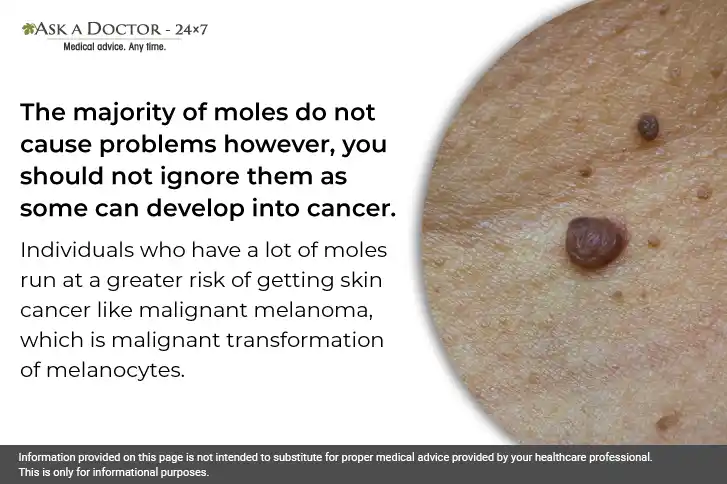Why New Moles Suddenly Appear And When To Worry?
Moles are nothing but a cluster of pigment cells. Almost every adult has common moles and you may have a few extras if your skin is fair. Moles may appear as flesh-colored bumps or small marks on the skin in varied colors, shapes, and sizes.
A typical mole can have the following characteristics:
- Shape: They can have a round or oval form.
- Color: They are often flesh-colored, reddish brown, or medium to dark brown in color.
- Size: The size of moles can vary greatly. They might be as little as a pinhead or cover an entire arm. They are usually not more than 6 mm (1/4 inch) in length.
Moles are usually nothing to worry about but rarely do they become cancerous. Being aware of changes in your moles is important to make an appointment with your healthcare provider. Here’s what you need to know about moles, including when you should consult a dermatologist.
What Causes Moles to Appear Suddenly?

Melanocytes in your epidermis, or top layer of skin, grow out of control and form clusters to produce moles. Although your body naturally contains melanocytes, internal and external events might cause modifications that lead to moles.
Common causes of a new mole include:
- Exposure to ultraviolet radiation: People raised in sunny climates typically develop more moles as compared to those with very low sun exposure.
- Hormonal Fluctuations: Hormone fluctuations can happen throughout pregnancy, puberty, and old age, and moles react to these changes. They typically increase in quantity during adolescence, darken during pregnancy, and eventually disappear as people age.
- Having fair skin: Fair skin has less melanin, hence less protective pigment.
- Genetics: A family history of moles increases your new mole predilection. You should be cautious if members of your close family have unusual or numerous moles, or if they may have had skin cancer in the past.
When To Worry About Moles
Unusual signs of moles may indicate skin cancer. You should be concerned if a mole changes in color, form, size, or height, or if its borders are uneven or asymmetrical.
Let’s look into the common indicators of skin cancer with the aid of the ABCDE guide:
- A represents an asymmetrical shape: The two halves of the mole are not the same.
- B represents border: Unusual moles have uneven, scalloped, or notched borders.
- C represents color changes: Watch out for growths with inconsistent, multicolored, or altered colors.
- D represents diameter: If a mole grows larger than 1/4 inch (about 6 mm) in diameter.
- E represents evolved (changed): Keep an eye out for moles that alter in appearance i.e., that evolve in height, shape, size, or color.
How To Prevent Moles?
Moles are natural skin growth that is unavoidable. Nonetheless, there are proactive ways to avoid skin cancer or detect it early:
- Reducing your exposure to sunshine
- Use sunscreen with a minimum of SPF 30 daily.
- Wearing protective clothing. Sunglasses, broad-brimmed hats, long sleeves, and other items of clothing can protect you from damaging UV rays.
- Self-examining your moles for anomalies at least once a month.
When to Contact a Healthcare Provider
Melanomas are self-detected in about 50% of cases. There is a 99% survival rate for melanoma that is found and treated before it spreads to the lymph nodes.
Notify your healthcare professional of any moles that meet the ABCDE requirements. Additionally, a medical professional should look at moles that exhibit any of the following traits:
- Development of an unusual new mole
- Moles that are unlike any others on your body
- Moles that do not heal
- Redness or swelling that extends beyond the edge of a mole
- Color that spreads from the edge of a spot into the surrounding skin
- Persistent or recurrent itching, tenderness, or pain in a mole
- Modifications to a mole's texture or surface, such as oozing, bleeding, or the formation of a lump
Thus, moles occur when melanocytes in the skin grow in a cluster instead of being spread throughout the skin. They often grow in response to hormonal changes, UV light exposure, or family traits. Most of the moles pose no threat but if you have a mole that fits the ABCDE guidance, it is pivotal to see your healthcare provider or a dermatologist. Also, if your mole oozes, bleeds, itches, or becomes sensitive or painful, you should get them looked out for prompt diagnosis and treatment.
If you have any questions about the appearance of new moles, you can Ask a Dermatologist at Ask a doctor, 24x7.
Recently Answered Questions Related to Moles and Skin Pigmentation
- Suggest Remedy For Moles On Buttocks
- What Are The Chances Of Melanoma After Removing Atypical Moles?
- Do Twenty Atypical Moles Or Twenty Moles Be An Indication Of FAMM? Does The Severity Matter In Terms Of Risk Of Melanoma?
- What Causes Small Light Brown Moles On My Upper Inside Thigh?
- Suggest Treatment For Unusually Pigmented Moles On Face
- Can Moles With Irregular Edges And Pigmentation Be An Indication Of Skin Cancer?
- What Causes Brown Pigmentation On Hand?
- What Is The Large Mole With the Same Pigmentation As Skin?
- What Kind Of Medical Test Can Be Done For Leg Aches After the Removal Of A Melanoma?
- What Causes Skin Pigmentation Like Spots In The Arm Suddenly?
Disclaimer: Information provided on this page is not intended to substitute for proper medical advice provided by your healthcare professional. This is only for informational purposes.
Ask a Specialist
Recent Questions


